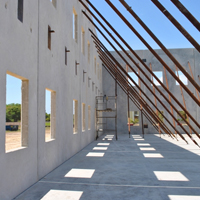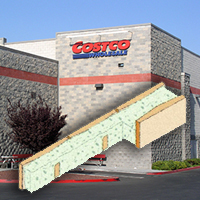Concrete block, or concrete masonry units (CMU) as cited in building codes, are not your typical concrete. The term "concrete” may evoke images of sidewalks, driveways, massive structures, and of course, buildings.
These are all forms of poured-in-place (PIP) concrete, and contain significant amounts of Portland cement, cited so often as a major contributor to global CO2 emissions. While it isn't the only major culprit, or the largest, it is the most recognizable and widely known, and no media story fails to mention it.
Not everything with "concrete” in its name is the same. CMU, though a type of concrete, has substantially less cement per volume compared to PIP concrete. Masonry grout, a type of concrete that fills the cells of CMU, is very different in composition than PIP, and can be altered to dramatically reduce its cement content.
As an example, let's examine a comparison of carbon impacts of tilt-up and concrete masonry. The flexibility of concrete masonry's components – CMU and masonry grout – offers exceptional low carbon potential.
Consider a structure with 100,000 square feet of wall area. This could be a large warehouse, industrial or office complex. We'll assume a 6-inch-thick tilt-up wall, and an 8-inch-thick concrete masonry wall. Of course, the tilt-up is all concrete; the concrete masonry wall consists of CMU and masonry grout.
| System | Percent of Wall | Mix Design Cementitious Content |
Portland Cement Needed |
Impact: CO2 Reduction |
||
| Cement | Cement Replacement1 | |||||
| Tilt-up: | 100% | 7-Sack | 15% Fly Ash | 524 Tons | - | |
| Concrete Masonry: | CMU | 55% | 2.5-Sack | - | 392 Tons | 165 Tons Less than Tilt |
| Masonry Grout | 45% | 7-Sack | 50% Fly Ash | |||
The significant decrease in cement afforded by concrete masonry cuts 132 tons of cement. That equates to 165 tons LESS CO2 than tilt-up, or 2.6 pounds less CO2 per square foot of wall area.2
CMU have low cement usage and begin as a low-impact material. Masonry grout has enormous potential for cement and carbon reduction by using supplementary cementitious materials (SCM). Fly ash and fly ash/ground granulated blast furnace slag blends have been studied as SCM in high percentages, up to 80%. This research indicates high SCM masonry grout as a viable structural, sustainable, and economic alternative to conventional grout.1
All of that is impressive and promising, yet Angelus Block has lowered the CMU-related CO2 even further with CarbonKind™ Low Carbon Concrete Masonry Units.
1 Bradfield, Maribeth, High Supplemental Cementitious Material (SCM) Grout Phase 2 and 3 Research, Masonry Chronicles, Winter 2010-11, Concrete Masonry Association of California and Nevada, Masonry_Chron_Winter_2010-11.pdf
2 Siggard, Kurt, Less Cement - The Choice is Concrete Masonry, Concrete Masonry Association of California and Nevada.


 CarbonKind Low Carbon CMU
CarbonKind Low Carbon CMU
